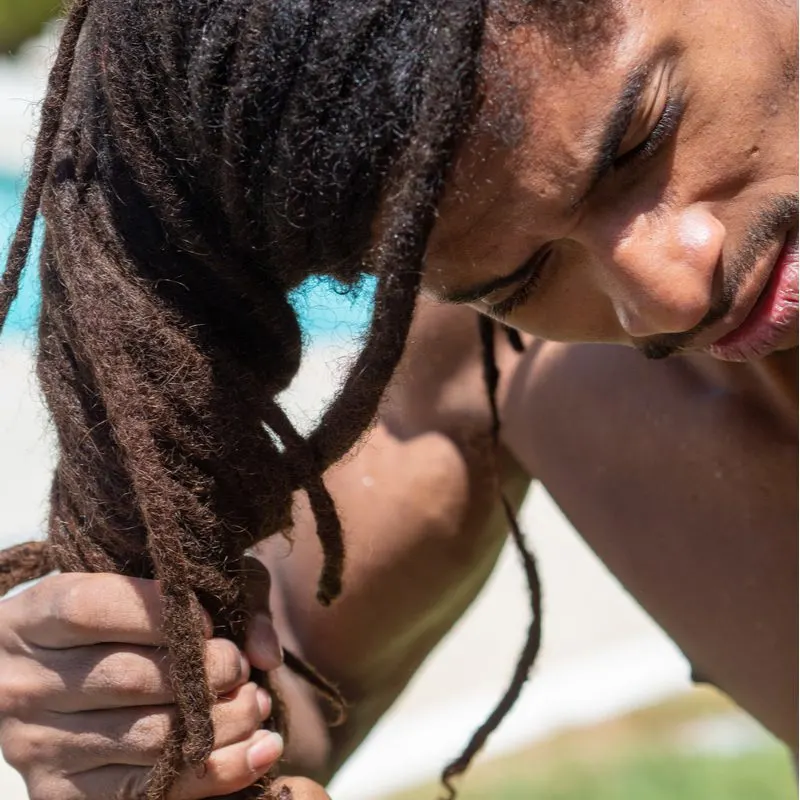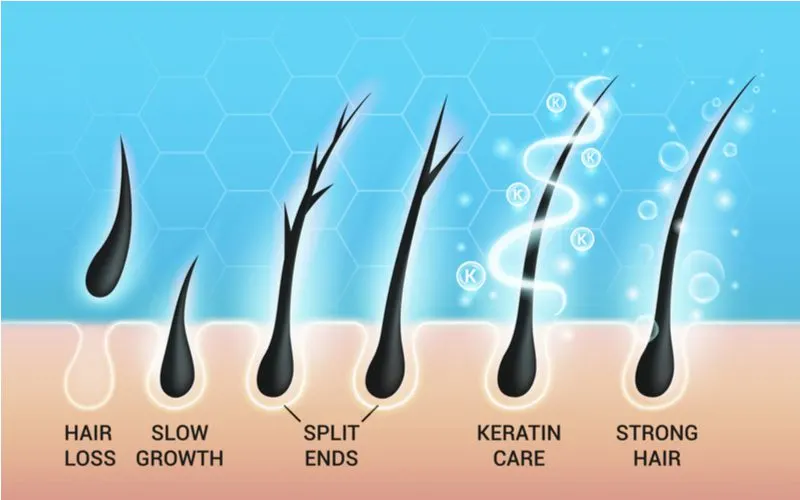Jump to:
As hair grows, it puts pressure on the scalp, leading to your dreads thinning at the root. It’s an issue you should address early because it can cause weak spots in your locs and lead to breakage. Read on to learn more.
Uh Oh. Dreads Thinning at the Root?

CarlosDavid/Shutterstock
Dreads thinning at the root should be easy to identify. The loc might feel skinny at the crown or become loose. You might see broken hair follicles or might deal with broken dreads.
A few thins to consider:
- It’s normal for the thickness of your locks to change, especially during their first year. Your hair needs time to settle into coils. However, healthy dreads will typically become thicker over time.
- Don’t worry. Dealing with thinning dread roots is a common issue. It can be the result of unhealthy hair or failure to maintain your dreads properly.
- Don’t wait for the issue to get worse. There are steps you can take to get healthier dread roots.
Is It an Issue with Weight and Tension?
When forming dreads, locticians weave the hair together to form tight coils. There are different patterns you can use to weave the hair together, and depending on the technique used, the coil might be too tight and put pressure on the scalp.
Tight dreads can cause traction alopecia. This condition can also appear if you wear other tight hairstyles. It can also be the result of dreads that have become too heavy for your scalp.
Identifying Traction Alopecia
Traction alopecia usually causes your dreads to become thin at the root and to fall out. You might also find short broken hair at the crown of your dreads and notice that your hairline is receding. In some cases, traction alopecia can cause discomfort and even headaches.
How To Address Traction Alopecia
You can prevent traction alopecia by choosing a stylist who has an extensive background when it comes to working on locks. You should also avoid tight hairstyles that can put pressure on your scalp, such as wearing your dreads in a high bun.
If you’re developing signs of traction alopecia, don’t wait. You should visit a professional to either have your dreads partially cut to remove some of the weight or to have your locks removed.
If you decide to get locks again in the future, avoid conjoining dreads and ask your loctician to work with small sections of hair to reduce the weight. You should let your stylist know you’ve dealt with traction alopecia in the past and ask them to use a weaving pattern that won’t feel too tight.
Managing New Hair Growth

elebZoom/Shutterstock
When a professional forms a dread, they use the entire length of the hair to create a strong coil. However, you will get new hair growth at the crown of the dread. You need to incorporate the new growth into your locks by twisting it into the coil.
If you fail to manage new hair growth, you will develop thinning roots.
It’s also important to twist the new growth in the right direction when incorporating it into an existing lock. If you go against the pattern of your locs, your dreads will get weak spots that can lead to breakage.
Why Managing New Hair Growth Is Important
Failing to incorporate new hair growth into your dread can be a cosmetic problem. However, because dreads tend to become thicker and heavier over time, you need to use new hair growth to support them.
If you don’t twist new hair as it grows, you will get weak dread roots and will eventually have to deal with breakage.
How To Manage New Hair Growth
A common mistake is to trim the new hair growth to make your dreads look neater. Again, you need that new hair growth to get strong and healthy locks. You can either learn to twist new hair growth yourself or visit your loctician regularly to have them maintain your dreads.
On average, hair grows at a rate of half an inch each month. You should see your stylist every two to three months to twist the new hair growth, or more often if your hair grows faster.
Is It a Scalp Health Issue?

MarySan/Shutterstock
It’s possible to develop some health conditions that affect the skin of your scalp. If you have a scalp health problem, you will usually get weak and dry hair. Psoriasis, eczema, dermatitis, and fungal infections are some of the most common issues that can affect your scalp.
Assessing Scalp Health
If there is an issue with your scalp, you will probably notice symptoms like itching or inflammation. Some conditions can also cause scales, lesions, or dandruff to appear.
How to Treat a Scalp Health Problem
There are different treatment options to get a healthier scalp. Topical treatments like medicated shampoos work well for mild cases of psoriasis or dermatitis. If you’re dealing with more severe inflammation, you should consider corticosteroids.
In some cases, you’ll need an antibacterial or antifungal treatment to deal with a skin infection. It’s best to see a dermatologist to get a diagnosis and treatment plan. Your dread roots should become healthy again once you address the underlying scalp health condition.
Unhealthy Hair

Antonia Vlasova/Shutterstock
Hair can become dry and weak for many reasons. A health condition, medication, or even an unhealthy diet can cause your dread roots to look thin and unhealthy.
Common Signs of Unhealthy Hair
If you notice that, besides developing thinning roots, your locks are dry and brittle, you might be dealing with a hair health issue. Hair loss and dreads that are difficult to style can also indicate a hair health problem.
What to Do About Unhealthy Hair
You can get healthier hair by adopting a diet that is rich in vitamins and minerals:
- Eat plenty of seeds, nuts, seafood, and soybeans to get the fatty acids your hair needs.
- Bananas, potatoes, and other foods rich in vitamin B6 are also important.
- You need to eat meat, poultry, fish, or dairy products every day to get Vitamin B12.
- Citrus and tomatoes are great sources of folic acid.
You also need a hair care regimen adapted to your unique needs. Natural oils like coconut oil and tea tree oil can do wonders for your dreads. These oils can keep your hair healthy while moisturizing it.
Tea tree oil also has antibacterial and antifungal properties that can support scalp health. A common practice is to use wax to help the dreads form strong knots and mature.
Using wax can actually weaken your locks since it will build up and add weight to the dreads. You should also avoid using color. Hair coloring products contain chemicals that can damage your hair and cause it to become dry and brittle.
Things to Consider if You’re Dealing With Thinning Dread Roots
Thinning dread roots is a common issue, but there are some simple solutions you can implement:
- Did your loctician use the right technique when forming your dreads? If not, go see a different professional and ask them to remove your dreads.
- Are your thinning roots the result of new hair growth? If yes, go see your stylist more regularly to manage the new growth.
- A hair care regimen adapted to your locks will help you get healthy roots.
- You should also consider scalp and hair health issues that can cause dry hair and breakage.
Thinning Dreads FAQ
Read on to learn more about thinning dread roots.
How Do You Tell If Dreads Are Thinning?
Your roots will look thinner than the rest of the dread. You might also find short broken hair at the crown of your locks.
What to Do If Dreads Are Thinning
You should change your hair care regimen and go see your loctician.
What Causes Locs to Thin?
Locks can thin for several reasons, including weight and pressure, unhealthy hair, or an improper weaving technique.
So, Why Are My Dreads Thinning at the Root?
Thinning dread roots are an issue that can result from heavy or tight dreads. In some cases, thinning roots can also indicate an issue with your scalp or hair.
Or, the thinning is the result of new hair growth that you aren’t managing properly. Thankfully, there are simple steps you can take to maintain your dreads and prevent this issue.
